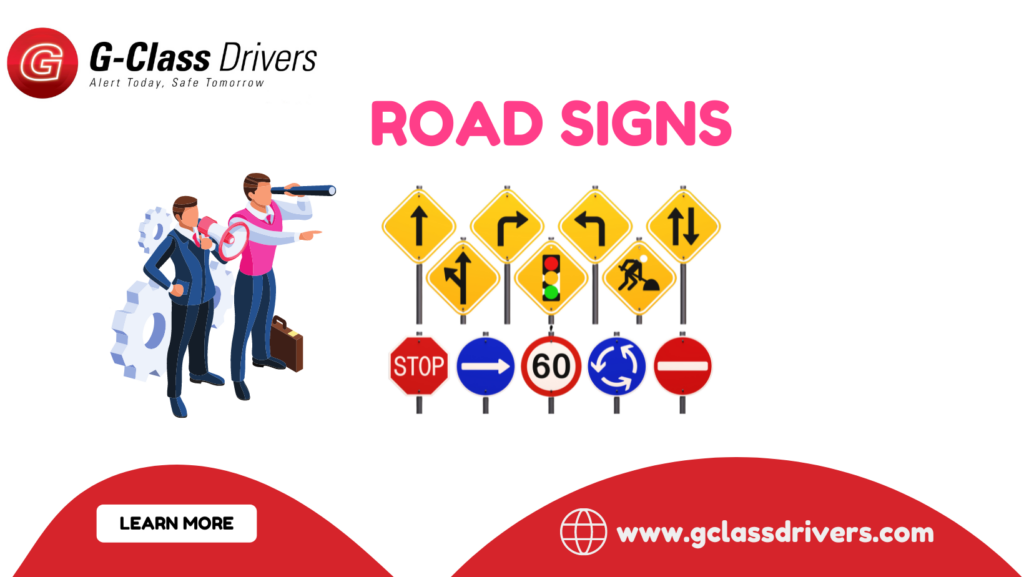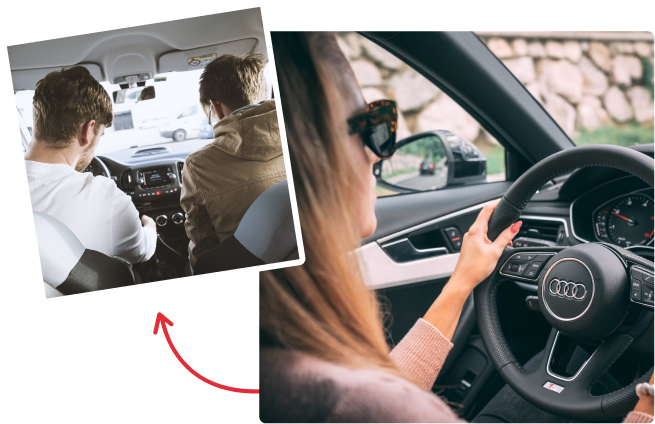All of us do agree that road signs are not just information, they can be life-saving! Right? Drivers need to pay attention to them. From speed limits to directional signs, these signs are your guide to a smooth and safe journey. You can say that these essential signs are like a language of the road. Learn to read them and you’ll navigate with confidence!
Read also: How to Overcome Driver Anxiety?
What are Road Signs?
Road designs are basically for the safety of the driver and for the pedestrians. These signs help you stay safe and informed on the road. You should not underestimate the power of road sign. Their purpose is to keep you and others on the road out of harm’s way. Drivers of Canada need to be careful as the roads aren’t always clear and these driving signs are an extra mess. But these road signs are there for a reason.
They will help you arrive at your destination safely. Whether you are a beginner or an experienced driver, you need to pay proper attention to the signs. These signs aren’t just a regulatory requirement. They are kind of tips and warnings that will help you avoid wrong turns or in worst scenarios any accidents.
Types of Road Signs
Regarding the signs there is a long list but the following three categories should be known by everyone:
Regulatory Road Sign
These signs convey information to the drivers and include the traffic rules and regulations. Road safety protocols to keep a smooth flow of traffic are also included in these signs. Some signs are also applicable in certain conditions.
These include under specific weather conditions, time, location, etc. the typical example start stop signs, one way signs, speed limits etc. these signs are present on the road to inform the driver of the upcoming situations.
Warning Road Sign
As the name indicates, these signs are to alert the drivers. These signs indicate that there might be a potential hazard ahead. It also informs the drivers about upcoming driving schools, animal crossing, pedestrian crossing, or potential traffic.
These are mostly pennant shaped and are in yellow striking color to attract the attention of drivers. The common examples are slippery road conditions, bend ahead and roundabout ahead.
Guide Road Sign
The guide signs are designed in a rectangular shape and are in green or white color. These signs are used to deliver location specific information. Although depending on the message their shape and size can vary. The examples include hiking, parking, exit or entry signs etc.
Commonly Used Shapes
There are several road shapes that have different meanings. These signs are designed to give you important information regarding the traffic laws. The signs are helpful to know about the dangerous conditions. The commonly used shapes are as follows:
- Octagons- These signs are for stop which means that the driver needs to stop. These designs are mostly red in color
- Pentagons- These signs are generally used near school zones and are painted brightly to attract the attention of drivers.
- Equilateral Triangles- These are designed to make you aware of the upcoming layouts that includes mountains, hills or tunnels
- Circles- The circle sign means legal order or prohibition.
- Crossbucks- A massive X indicates upcoming railway crossings. The sign indicates that you need to stop while the train is crossing.
- Rectangular- These rectangular signs are mostly restricted to motorbike ride rules. These signs also tell us about certain hazards.
Colors of Road Signs
Certain colors of road sign have different meanings. Some of the common colors used in road signs boards are as follows:
- Black- The black sign indicates general road conditions and is used for regulatory road signs
- Blue- The blue sign is for guiding signboards that tells the information about specific location
- Brown- The brown color highlights the national or provincial parks in the area.
- Green- The green sign is an informational or guidance sign, this sign tells us about the distance to a specific location.
- Red- A sign having red background color indicates a warning sign. It is basically a stop or yield sign.
- Purple- This sign indicates that there are amusement parks nearby but these signs are often rare.
- Orange- The orange background sign is for construction or maintenance purposes. You will be fined double if you don’t follow this sign
- White- The white sign is only for regulatory road signs.
- Yellow- The yellow background sign means warning. So if you see this sign then you need to be aware of your surroundings.
15 Common & Uncommon Road Signs
Some of the common road signs are as follows:
Stop Sign
When you see the eight-sided stop sign you must come to a complete stop. If there’s a line stop there if not stop at the edge of crosswalk. Continue when it’s safe. The sign on the right warns that a stop sign is ahead, so slow down.
School Zone Signs
When you see this sign, slow down and watch for children crossing. During school hours, the speed limit may be reduced. Watch for flashing lights and adjust your speed accordingly.
Yield Sign
When you see this sign, yield to traffic at the upcoming intersection. Stop if needed, and proceed cautiously when it’s clear.
Do Not Enter Sign
A Do Not Enter sign means you must not enter the road, ramp or crossover where the sign is posted. It usually indicates opposing traffic coming towards you. When you see this sign, do not enter.
Parking Signs
Parking signs indicate specific rules in an area. The left sign means you can stop briefly to drop off or unload, but not park for long. The right sign allows parking only between the two signs and only during the specified times.
HOV Lane Road Signs
HOV stands for High Occupancy Vehicles, mainly for buses or vehicles with multiple passengers. Only vehicles with the required number of passengers can use this lane. You cannot enter the HOV lane if there’s a solid line, as indicated by the sign on the right.
One Way Street Sign
One-way signs indicate the direction traffic must follow. Drivers must not go against this direction to avoid head-on collisions. The sign is rectangular with a black background and a white arrow showing the correct direction.
Railway Road Sign
A cross sign indicates a railway crossing ahead. It warns drivers that train tracks intersect the road. When you see this sign, slow down look both ways and be ready to stop if a train is coming. Flashing lights usually signal an approaching train.
Warning Signs
A triangle with an exclamation mark is a warning sign. It alerts people to health and safety hazards beyond what a caution sign indicates. Specific warning signs may vary based on the type of hazard present.
Some of the uncommon road signs are as follows:
Deer Crossing
This sign is common in Canadian parks and warns of potential deer crossings. In Ontario, wildlife-related accidents caused 145 injuries and one death in 2018. When you see this sign stay alert as deer or other wildlife may cross the road at any time.
Pavement Ends
This sign means the paved road is ending and will likely turn into a gravel road. It’s not as dangerous as it might seem but it’s important for drivers to slow down and prepare for a rougher bumpier ride.
Swirly Looking Plant
If you’re not from New Brunswick this sign might confuse you it’s not a plant. This is the River Valley Scenic Drive sign marking the 512 km scenic route through province.
Falling Rocks
This sign warns of falling rocks a potential hazard on highways near steep areas. Falling rocks can be dangerous and may lead to road closures. If you see this sign proceed with caution.
Bike Lanes
This sign indicates a dedicated bike lane on the roadway. Bike lanes enhance safety for both cyclists and motorists. In Toronto bike lanes reduced car crashes by 71% in 2017.
Snowmobiles On Roadway
This sign, common in northern regions, warns of potential snowmobile crossings. Snowmobile trails often intersect roads so watch for snowmobiles, which are smaller and harder to see than other vehicles.
Conclusion
To conclude, Road Signs play a very crucial role in guiding and informing the drivers about the upcoming situation. These signs are designed to give specific information such as speed limits, warnings or prohibitions.
The signs basically help you find your way to your destination in a safe way. Understanding and obeying road sign boards is essential for safe and responsible driving. By following the road sign regulations a driver plays a crucial part of maintaining order and safety on our roadways.
Read also: How to get your Boating License in Ontario?
FAQs
What do regulatory road signs indicate?
Regulatory road signs provide information about traffic laws and regulations, such as speed limits, stop signs, and one-way directions. They ensure smooth and safe traffic flow.
How can warning road signs help drivers?
Warning road signs alert drivers to potential hazards or changes in road conditions ahead, such as slippery roads, pedestrian crossings, or sharp turns, helping them to adjust their driving accordingly.
What is the purpose of guide road signs?
Guide road signs offer information about locations, directions, and distances, helping drivers navigate to their destinations, such as exit signs, parking areas, and rest stops.
Why are road sign colors important?
Road sign colors convey different types of information: red for warnings or prohibitions, yellow for cautions, green for guidance, and blue for service information. Colors help drivers quickly understand the message of the sign.
What should I do when I see a ‘Do Not Enter’ sign?
When you encounter a ‘Do Not Enter’ sign, you must not enter the road or area indicated. It typically signals that the road is restricted or that traffic is moving in the opposite direction.





